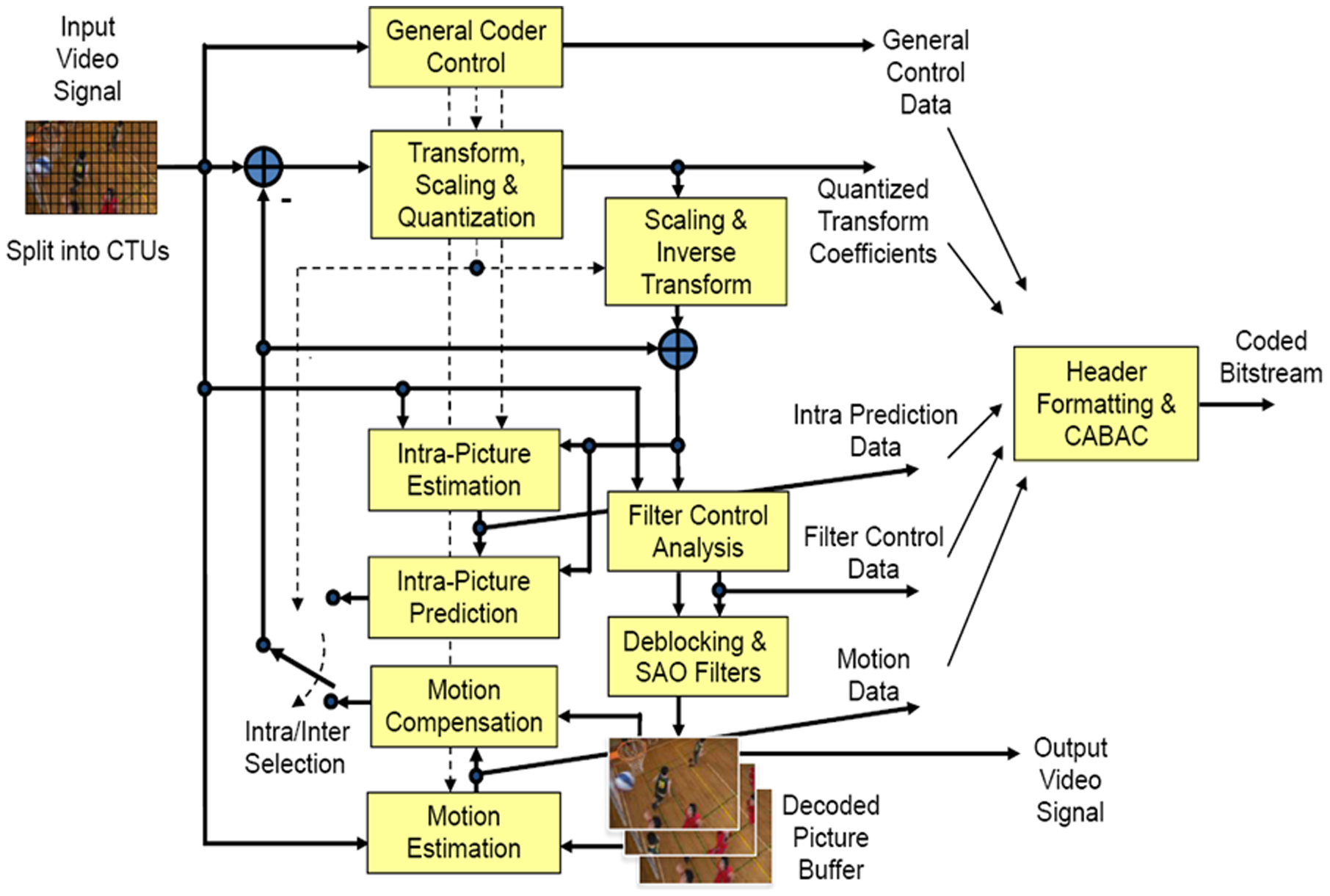|
Av1
AOMedia Video 1 (AV1) is an open, royalty-free video coding format initially designed for video transmissions over the Internet. It was developed as a successor to VP9 by the Alliance for Open Media (AOMedia), a consortium founded in 2015 that includes semiconductor firms, video on demand providers, video content producers, software development companies and web browser vendors. The AV1 bitstream specification includes a reference video codec. In 2018, Facebook conducted testing that approximated real-world conditions, and the AV1 reference encoder achieved 34%, 46.2%, and 50.3% higher data compression than libvpx-vp9, x264 High profile, and x264 Main profile respectively. Like VP9, but unlike H.264 (AVC) and H.265 (HEVC), AV1 has a royalty-free licensing model that does not hinder adoption in open-source projects. AVIF is an image file format that uses AV1 compression algorithms. History The Alliance's motivations for creating AV1 included the high cost and uncertainty ... [...More Info...] [...Related Items...] OR: [Wikipedia] [Google] [Baidu] |
Alliance For Open Media
The Alliance for Open Media (AOMedia) is a non-profit industry consortium headquartered in Wakefield, Massachusetts, and formed to develop open, royalty-free technology for multimedia delivery. It uses the ideas and principles of open web standard development to create video standards that can serve as alternatives to the hitherto dominant standards of the Moving Picture Experts Group (MPEG). Its first project was to develop AV1, a new open video codec and format, as a successor to VP9 and an alternative to HEVC. AV1 uses elements from Daala, Thor, and VP10, three preceding open video codecs. The governing members of the Alliance for Open Media are Amazon, Apple, ARM, Cisco, Google, Huawei, Intel, Meta Platforms, Microsoft, Mozilla, Netflix, Nvidia, Samsung Electronics and Tencent. History Some collaboration and work that would later be merged into AV1 predates the official launch of the Alliance. Following the successful standardization of an audio standard in the Int ... [...More Info...] [...Related Items...] OR: [Wikipedia] [Google] [Baidu] |
Facebook
Facebook is a social media and social networking service owned by the American technology conglomerate Meta Platforms, Meta. Created in 2004 by Mark Zuckerberg with four other Harvard College students and roommates, Eduardo Saverin, Andrew McCollum, Dustin Moskovitz, and Chris Hughes, its name derives from the face book directories often given to American university students. Membership was initially limited to Harvard students, gradually expanding to other North American universities. Since 2006, Facebook allows everyone to register from 13 years old, except in the case of a handful of nations, where the age requirement is 14 years. , Facebook claimed almost 3.07 billion monthly active users worldwide. , Facebook ranked as the List of most-visited websites, third-most-visited website in the world, with 23% of its traffic coming from the United States. It was the most downloaded mobile app of the 2010s. Facebook can be accessed from devices with Internet connectivit ... [...More Info...] [...Related Items...] OR: [Wikipedia] [Google] [Baidu] |
Intel
Intel Corporation is an American multinational corporation and technology company headquartered in Santa Clara, California, and Delaware General Corporation Law, incorporated in Delaware. Intel designs, manufactures, and sells computer components such as central processing units (CPUs) and related products for business and consumer markets. It is one of the world's List of largest semiconductor chip manufacturers, largest semiconductor chip manufacturers by revenue, and ranked in the Fortune 500, ''Fortune'' 500 list of the List of largest companies in the United States by revenue, largest United States corporations by revenue for nearly a decade, from 2007 to 2016 Fiscal year, fiscal years, until it was removed from the ranking in 2018. In 2020, it was reinstated and ranked 45th, being the List of Fortune 500 computer software and information companies, 7th-largest technology company in the ranking. It was one of the first companies listed on Nasdaq. Intel supplies List of I ... [...More Info...] [...Related Items...] OR: [Wikipedia] [Google] [Baidu] |
Google
Google LLC (, ) is an American multinational corporation and technology company focusing on online advertising, search engine technology, cloud computing, computer software, quantum computing, e-commerce, consumer electronics, and artificial intelligence (AI). It has been referred to as "the most powerful company in the world" by the BBC and is one of the world's List of most valuable brands, most valuable brands. Google's parent company, Alphabet Inc., is one of the five Big Tech companies alongside Amazon (company), Amazon, Apple Inc., Apple, Meta Platforms, Meta, and Microsoft. Google was founded on September 4, 1998, by American computer scientists Larry Page and Sergey Brin. Together, they own about 14% of its publicly listed shares and control 56% of its stockholder voting power through super-voting stock. The company went public company, public via an initial public offering (IPO) in 2004. In 2015, Google was reorganized as a wholly owned subsidiary of Alphabet Inc. Go ... [...More Info...] [...Related Items...] OR: [Wikipedia] [Google] [Baidu] |
Cisco
Cisco Systems, Inc. (using the trademark Cisco) is an American multinational digital communications technology conglomerate corporation headquartered in San Jose, California. Cisco develops, manufactures, and sells networking hardware, software, telecommunications equipment and other high-technology services and products. Cisco specializes in specific tech markets, such as the Internet of things (IoT), domain security, videoconferencing, and energy management with products including Webex, OpenDNS, Jabber, Duo Security, Silicon One, and Jasper. Cisco Systems was founded in December 1984 by Leonard Bosack and Sandy Lerner, two Stanford University computer scientists who had been instrumental in connecting computers at Stanford. They pioneered the concept of a local area network (LAN) being used to connect distant computers over a multiprotocol router system. The company went public in 1990 and, by the end of the dot-com bubble in 2000, had a market capitali ... [...More Info...] [...Related Items...] OR: [Wikipedia] [Google] [Baidu] |
Amazon (company)
Amazon.com, Inc., doing business as Amazon, is an American Multinational corporation, multinational technology company engaged in e-commerce, cloud computing, online advertising, digital streaming, and artificial intelligence. Founded in 1994 by Jeff Bezos in Bellevue, Washington, the company originally started as an online marketplace for books but gradually expanded its offerings to include a wide range of product categories, referred to as "The Everything Store". Today, Amazon is considered one of the Big Tech, Big Five American technology companies, the other four being Alphabet Inc., Alphabet, Apple Inc., Apple, Meta Platforms, Meta, and Microsoft. The company has multiple subsidiaries, including Amazon Web Services, providing cloud computing; Zoox (company), Zoox, a self-driving car division; Kuiper Systems, a satellite Internet provider; and Amazon Lab126, a computer hardware R&D provider. Other subsidiaries include Ring (company), Ring, Twitch (service), Twitch, IMDb, ... [...More Info...] [...Related Items...] OR: [Wikipedia] [Google] [Baidu] |
Moving Picture Experts Group
The Moving Picture Experts Group (MPEG) is an alliance of working groups established jointly by ISO and IEC that sets standards for media coding, including compression coding of audio, video, graphics, and genomic data; and transmission and file formats for various applications.John Watkinson, ''The MPEG Handbook'', p. 1 Together with JPEG, MPEG is organized under ISO/IEC JTC 1/ SC 29 – ''Coding of audio, picture, multimedia and hypermedia information'' (ISO/IEC Joint Technical Committee 1, Subcommittee 29). MPEG formats are used in various multimedia systems. The most well known older MPEG media formats typically use MPEG-1, MPEG-2, and MPEG-4 AVC media coding and MPEG-2 systems transport streams and program streams. Newer systems typically use the MPEG base media file format and dynamic streaming (a.k.a. MPEG-DASH). History MPEG was established in 1988 by the initiative of Dr. Hiroshi Yasuda ( NTT) and Dr. Leonardo Chiariglione ( CSELT). Chiariglione was th ... [...More Info...] [...Related Items...] OR: [Wikipedia] [Google] [Baidu] |
Image File Format
An image file format is a file format for a digital image. There are many formats that can be used, such as JPEG, PNG, and GIF. Most formats up until 2022 were for storing 2D images, not 3D ones. The data stored in an image file format may be compressed or uncompressed. If the data is compressed, it may be done so using lossy compression or lossless compression. For graphic design applications, vector graphics, vector formats are often used. Some image file formats support Transparency (graphic), transparency. Raster formats are for 2D images. A 3D image can be represented within a 2D format, as in a stereogram or autostereogram, but this 3D image will not be a true light field, and thereby may cause the vergence-accommodation conflict. Image Computer file, files are composed of digital data in one of these formats so that the data can be displayed on a digital (computer) display or printed out using a printer. A common method for displaying digital image information has histori ... [...More Info...] [...Related Items...] OR: [Wikipedia] [Google] [Baidu] |
AVIF
AV1 Image File Format (AVIF) is an open, royalty-free image file format specification for storing images or image sequences compressed with AV1 in the HEIF container format. It competes with HEIC, which uses the same container format built upon ISOBMFF, but HEVC for compression. Version 1.0.0 of the AVIF specification was finalized in February 2019. Version 1.1.0 was finalized in April 2022. In a number of tests by Netflix in 2020, AVIF showed better compression efficiency than JPEG as well as better detail preservation, fewer blocking artifacts and less color bleeding around hard edges in composites of natural images, text, and graphics. AVIF support is available in all the major web browsers (i.e. over 93% of all web browsers). Features The AV1 Image File Format supports: * Multiple color spaces, including: ** HDR (with PQ or HLG transfer functions and BT.2020 color primaries, as part of BT.2100) *** Supports HDR gain map approach, backwards compatible with SDR di ... [...More Info...] [...Related Items...] OR: [Wikipedia] [Google] [Baidu] |
Reasonable And Non-discriminatory Licensing
Reasonable and non-discriminatory (RAND) terms, also known as fair, reasonable, and non-discriminatory (FRAND) terms, denote a voluntary licensing commitment that standards organizations often request from the owner of an intellectual property right (usually a patent) that is, or may become, essential to practice a technical standard. Put differently, a F/RAND commitment is a voluntary agreement between the standard-setting organization and the holder of essential patent, standard-essential patents. U.S. courts, as well as courts in other jurisdictions, have found that, in appropriate circumstances, the implementer of a standard—that is, a firm or entity that uses a standard to render a service or manufacture a product—is an intended third-party beneficiary of the FRAND agreement, and, as such, is entitled to certain rights conferred by that agreement. A standard-setting organization is an industry group that sets common standards for its particular industry to ensure compati ... [...More Info...] [...Related Items...] OR: [Wikipedia] [Google] [Baidu] |
High Efficiency Video Coding
High Efficiency Video Coding (HEVC), also known as H.265 and MPEG-H Part 2, is a video compression standard designed as part of the MPEG-H project as a successor to the widely used Advanced Video Coding (AVC, H.264, or MPEG-4 Part 10). In comparison to AVC, HEVC offers from 25% to 50% better data compression at the same level of video quality, or substantially improved video quality at the same bit rate. It supports resolutions up to 8192×4320, including 8K UHD, and unlike the primarily 8-bit AVC, HEVC's higher fidelity Main 10 profile has been incorporated into nearly all supporting hardware. While AVC uses the integer discrete cosine transform (DCT) with 4×4 and 8×8 block sizes, HEVC uses both integer DCT and discrete sine transform (DST) with varied block sizes between 4×4 and 32×32. The High Efficiency Image Format (HEIF) is based on HEVC. Concept In most ways, HEVC is an extension of the concepts in H.264/MPEG-4 AVC. Both work by comparing different parts of a fra ... [...More Info...] [...Related Items...] OR: [Wikipedia] [Google] [Baidu] |




